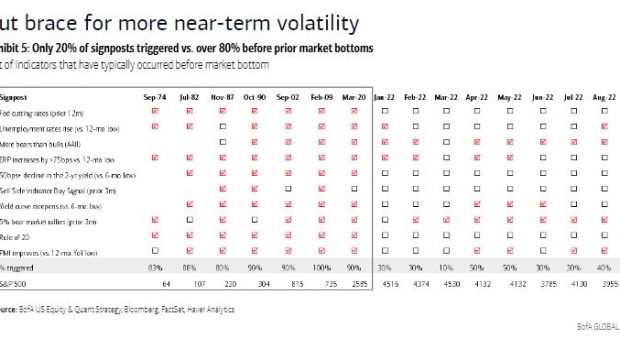Oct 14, 2022
BofA Sees Glimmers of Hope as Pain Lingers for Stock Investors
, Bloomberg News

(Bloomberg) -- Silver linings have begun to emerge in this year’s erratic stock market for long-term equity investors, according to Bank of America Corp. strategists led by Savita Subramanian.
The bank’s long-term valuation model points to an average annual price return of 6% for the S&P 500 Index over the next decade -- the highest level since May 2020. With 2% dividends, that would imply 8% in total returns, according to BofA. That marks an about-face for the bank. Its model heading into 2022 had forecast negative returns over the next 10 years.
“Valuation matters long-term,” Subramanian wrote in a note to clients Friday. “And this year’s bear market provides an attractive opportunity for long-term investors.”
Still, those projections are well below the S&P 500’s historical average. The average price return for the benchmark index in the past three decades sits around 10%, according to data compiled by Bloomberg. More equity volatility is likely in the short-run after September’s CPI report came in hotter than expected, which would likely force the Federal Reserve to remain steadfast with its aggressive interest-rate path, the strategists said.
“While the S&P 500 fell below our year-end target of 3,600, we continue to expect volatility in the market,” Subramanian said. “Hotter-than-expected services inflation strengthens the case for the Fed to stay hawkish, translating to a higher discount rate and increasing the risk of a harder landing.”
Read: BofA Sees More Pain In Store for Stocks After ‘Bear Hug’ Rally
While investors are eagerly awaiting signs of capitulation in the US stock market, long-term investors need to brace themselves for more turbulence and pain. The bank’s bull market signposts suggest that the market hasn’t yet bottomed, with only 20% currently triggered versus more than 80% before prior market bottoms.
For one thing, equity-risk premium -- the excess return earned by investors over a risk-free rate -- has typically increased by more than 75 basis points before a market bottom has been set. But that hasn’t happened yet.
In fact, multiple compressions in the S&P 500 have been driven so far by higher rates, not higher equity-risk premium, according to Subramanian. As the market prices in earnings risk into a recession, the equity-risk premium should rise, she explained.
“This is particularly concerning for equities, as prior recessions have typically resulted in lower rates, somewhat offsetting the impact of higher ERP,” Subramanian added. “But continued inflationary pressure pushes the Fed to remain hawkish. If rates remain elevated and the ERP rises, that would be the worst outcome for equities.”
©2022 Bloomberg L.P.






